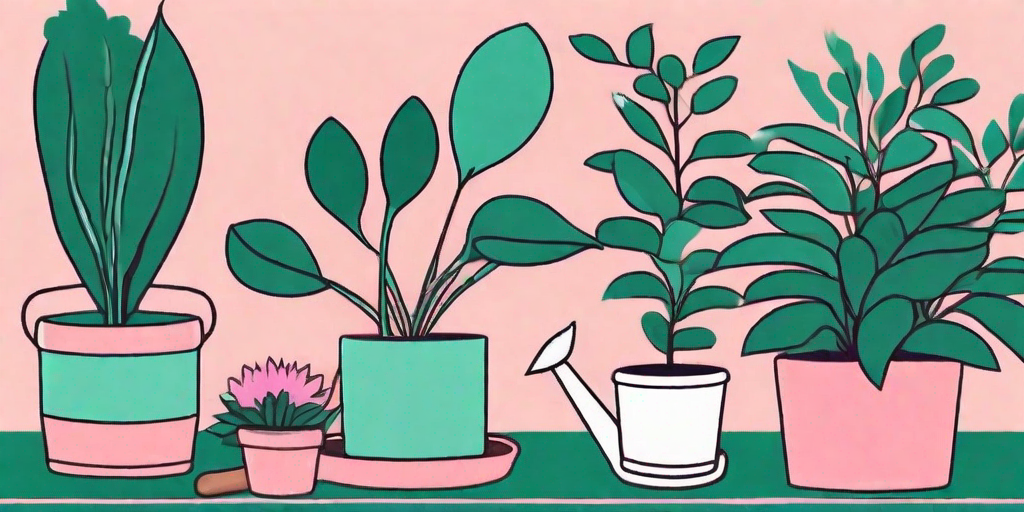
If you're a plant lover looking to add a dash of color and a pinch of exoticism to your indoor garden, the Pink Quill plant is your perfect match. This tropical beauty, also known as Tillandsia cyanea, is a bromeliad native to the rainforests of Ecuador. With its vibrant pink bracts and stunning blue-purple flowers, it's sure to turn heads and spark conversations. But how do you care for this stunning plant? Fear not, green-thumbed reader, for we have all the answers.
Understanding the Pink Quill Plant
The Pink Quill plant is a unique specimen in the plant kingdom. Unlike most plants, it doesn't require soil to grow. Instead, it absorbs nutrients and moisture through its leaves. This epiphytic nature makes it a low-maintenance and versatile addition to your indoor garden.
But don't let its easy-going nature fool you. The Pink Quill plant has a dramatic side too. Its name comes from the large, bright pink bract that grows from the center of the plant, resembling a feathered quill. This 'quill' is actually a flower spike, from which delicate purple flowers bloom.
The Lifecycle of a Pink Quill Plant
Like all bromeliads, the Pink Quill plant has a fascinating lifecycle. It begins as a pup, growing from the base of a mature plant. Once it reaches maturity, it produces its signature pink quill and blooms. After blooming, the plant will slowly die, but not before producing more pups to continue the cycle.
This lifecycle can take several years, giving you plenty of time to enjoy the beauty of your Pink Quill plant. And with proper care, you can encourage the production of multiple pups, expanding your collection without needing to purchase more plants.
Caring for Your Pink Quill Plant
Now that you're familiar with the Pink Quill plant, let's delve into the nitty-gritty of plant care. Despite its exotic origins, the Pink Quill plant is surprisingly easy to care for. It thrives in bright, indirect light and requires minimal watering. However, there are a few key points to keep in mind to ensure your plant stays happy and healthy.
Lighting
The Pink Quill plant loves light, but not too much. Direct sunlight can scorch its leaves, so it's best to place it in a spot with bright, indirect light. A north or east-facing window is ideal. If you notice the leaves turning yellow or brown, it may be getting too much light.
Watering
When it comes to watering, less is more. The Pink Quill plant is adapted to survive in dry conditions, so it's important not to overwater it. A good rule of thumb is to water it once a week, or when the top inch of the potting mix is dry. Be sure to water the base of the plant, not the leaves, to prevent rot.
Temperature and Humidity
The Pink Quill plant prefers warm temperatures and high humidity, much like its rainforest home. It will do well in temperatures between 60 and 80 degrees Fahrenheit, and humidity levels of 40-60%. If your home is dry, consider using a humidifier or placing the plant on a tray of pebbles with water to increase humidity.
Propagating Your Pink Quill Plant
One of the joys of owning a Pink Quill plant is watching it produce pups and starting the lifecycle anew. Propagating these pups is a simple process, and a great way to expand your plant collection or share the love with friends and family.
When to Propagate
The best time to propagate a Pink Quill plant is when the pup is about one-third the size of the mother plant. At this stage, the pup is mature enough to survive on its own, but still young enough to adapt to a new environment.
How to Propagate
Propagating a Pink Quill plant is as easy as pie. Simply cut the pup from the mother plant with a clean, sharp knife, making sure to leave some roots attached. Then, place the pup in a pot with a well-draining potting mix, and care for it as you would a mature plant.
Frequently Asked Questions
Why are the leaves on my Pink Quill plant turning brown?
Brown leaves can be a sign of overwatering or too much light. Check the moisture level of your potting mix and the location of your plant to determine the cause.
Why isn't my Pink Quill plant blooming?
Pink Quill plants only bloom once in their lifetime, and it can take several years for a pup to reach maturity and produce a bloom. Be patient, and make sure your plant is getting the right care to encourage blooming.
Can I grow a Pink Quill plant outdoors?
While Pink Quill plants can survive outdoors in warm, humid climates, they are best suited to indoor growing. They are sensitive to cold temperatures and can be damaged by direct sunlight.
Conclusion
With its vibrant colors and unique growth habits, the Pink Quill plant is a true gem in the world of indoor gardening. Whether you're a seasoned plant parent or a budding green thumb, this plant is sure to bring joy and beauty to your home. So why wait? Unleash the beauty of the Pink Quill plant today!















